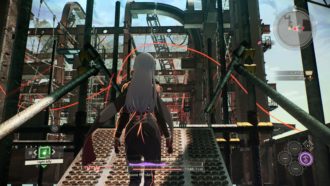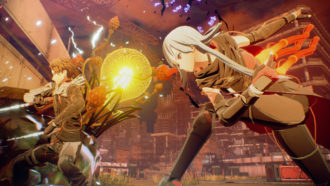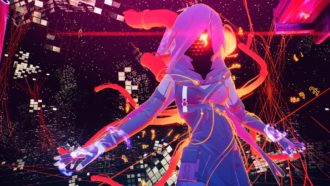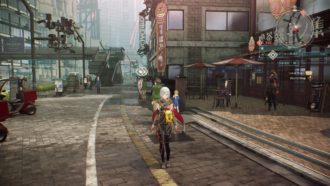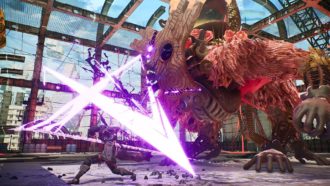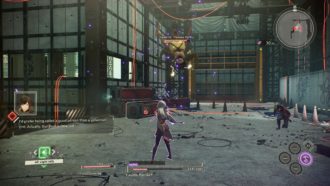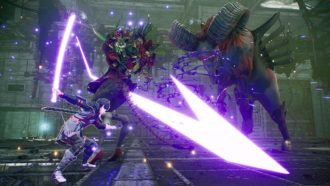Platforms:
Xbox One, PS4, PC, PS5, Xbox Series X|S
Released:
June 25, 2021
Publisher:
Bandai Namco Entertainment
Developer:
Bandai Namco Entertainment
Anime inspired action RPG’s come and go, and it takes something special to stand out from the pack. When Scarlet Nexus was announced, it certainly looked the part with dual protagonists and flashy action scenes that would fit comfortably in the genre’s zany wheelhouse, but it wasn’t until I got my hands on the title a couple of months ago that I truly understood how brilliant it was in motion. Featuring a strange future with a unique aesthetic, an incredibly likeable cast of misfits to spend time with and one of the most exciting and creative combat systems in recent memory, Scarlet Nexus presents a pretty enthralling package that had me heavily invested in its campaign and still keen to take part in more battles, long after my first playthrough was complete.
At the beginning of the game, you’ll have the choice of two protagonists who have different stories that intersect throughout. Yuito is a more traditional hero, with a close-range style of combat and plucky enthusiasm, while Kasane is a bit more aloof and complex as a character. I chose Kasane for my first playthrough, looking for a more untraditional approach, and found her to be a compelling lead. Kasane is fiercely loyal to her sister but quite stoic with everyone else around her. Not easy to make friends with, she’s blunt and focused. As the story evolves, the cracks in Kasane’s steely exterior begin to show, and I grew fond of her quite quickly.
Set in the far distant future, Scarlet Nexus is described as having a “Brainpunk” aesthetic, which means that we’re looking at a bit of a cyberpunk future with an anime twist. A psionic hormone was discovered in the human brain, granting people extra-sensory powers; people now communicate telepathically, augmented reality advertisements are everywhere in the streets and some deranged mutants known as Others began to descend from the sky with a hunger for human brains. Those with acute extra-sensory abilities, known in this world as psionics, are scouted for their talents and recruited to the Other Suppression Force (OSF), humanity’s last line of defence. While the story is certainly interesting across the board, there are some lengthy cutscenes that serve as information dumps; it’s not unusual to not have any control over your character for upwards of 10 minutes as conversations play out. There’s lots of dialogue, almost as far as to say the game taps into a visual novel style at times, which can be a bit jarring.
“There’s a slick rhythm to combat when you’re firing on all cylinders and chaining together combos…”
Both Yuito and Kasane are equipped with Psychokinesis, allowing them to fling objects at enemies with their minds. Psychokinesis is charged up by the basic attacks so you’ll constantly have to flip between them as you’re battling a range of enemies; there’s also a separate stun bar on each enemy that can be chipped away at with specific abilities that allow you to trigger a brain crush, finishing them off in dramatic anime fashion with a stylish KO that I never got bored of. There’s a slick rhythm to combat when you’re firing on all cylinders and chaining together combos on multiple enemies at once, which reminded me of other strong combat-focused experiences like Astral Chain and Devil May Cry in the way you juggle enemies with move after move until they’re ready to explode into pieces.
Additionally, you’re able to temporarily borrow the powers of those close to them through a system called SAS (Struggle Arms System). This extra layer to combat means that at any time, you can tap into your party to use their abilities. Some of the more offensive options include using fire or electricity to make your attacks stronger, but particular enemies will have specific weaknesses you need to exploit. For example, some enemies are invisible, so using clairvoyance allows you to uncover where they’re hiding. Other enemies retreat into an impenetrable shell when you get too close, so you have to use super-speed or invisibility to sneak up on them and catch them while they’re vulnerable. Learning what makes each enemy tick is enjoyable, and when there are multiple attacking at once, combat becomes a bit of a puzzle as you navigate each of them, focusing in on the SAS abilities to maximise damage wherever possible.
Another super fun wrinkle to combat is the ability to use your Psychokinesis to use your environment in creative ways. A battle on a construction site means you can use forklifts as battering rams that run over nearby targets. On an empty highway, you can take control of a bus, mowing down whatever is in your path. Chandeliers become spinning weapons of death. These are just some examples, but most rooms will have at least a couple of environmental attacks that filled me with glee whenever I had the opportunity to use them; not only are they enjoyable to trigger with some simple QTEs, but they always deal large amounts of pain to your foes, so tactically speaking it made sense to try and use them on the stronger enemies while you pummel the smaller ones with your more basic attacks.
That’s not all when it comes to battling. As your character evolves, you’ll gain access to Brain Drive, which essentially heightens all of your abilities for a short period of time, triggered automatically from gaining lots of kills. Then, there’s the Brain Field, a transformative experience that even further excels your Psychokinesis in a cool way that I won’t spoil. It’s incredibly impressive that Scarlet Nexus manages to spin so many plates when it comes to combat, and that they all work seamlessly together – it’s one of the most complex and addictive combat systems I’ve encountered in a long time.
It’s not all about combat, however. Bonding episodes are a chance to get to know your crew, which also directly impacts their abilities and makes them more useful in battle, for example increasing recovery speed or enhancing their core ability. These bonding episodes can happen during the standby phase or at other points in the story by responding to brain (text) messages. I appreciated the insight into my team, but the majority of these episodes played out as conversations that you merely observe and have no say in, no decisions to make. Still, choosing not to bond results in some gameplay mechanics that you’ll miss out on entirely, such as the ability to have them jump in and land a damaging blow during certain enemy conditions, so I’d say they’re worth doing, and the stories of each party member are interesting. They all have their own personalities and are well written with strong voice acting, so whenever the opportunity came to get to know them, I absolutely took it.
The crew themselves are varied and interesting; Kyoka is a protective mother type who I couldn’t help but get attached to early due to her sweet nature, although she acts differently when in battle. Arashi is brash, cheeky and tends to value chilling out alone, not seeing a lot of value in personal relationships. Shiden is ultra competitive with a real chip on his shoulder. There’s many more, and they’re all well realised. Additionally, you can give them gifts to increase your bonding levels with each of them. I like that when you give your team members gifts, that object then appears physically in your hideout and you can see them actually interacting with them. I got a weird sense of enjoyment seeing my new friends enjoy the gifts I’d given them and watching my once empty home fill with personality. Overall, it was entertaining to see those relationships evolve, and as expected, this meant that I felt more connected to them on the battlefield as well – considering there are so many characters in Scarlet Nexus, the fact that I liked spending time with each and every one of them is a testament to the writing and structure.
“…the fact that I liked spending time with each and every character is a testament to the writing and structure.”
Aside from the bonding allowing your party to grow stronger, there’s also a skill tree (called the brain map) which has you making decisions on what to prioritise – as there isn’t really many equipment upgrades, this is the core of where your new abilities and powers come from. Will you increase support allowing you to have extra plugins to aid you, or focus on enhancing the Brain Drive which can really turn the tide of battle? Unlike skill trees in other games, I found the upgrades to be mostly fairly useful instantly, whether it was offering an extra dash or generating more experience from finishing moves.
Scarlet Nexus has many locations that give off a post-apocalyptic style, which means they’re mostly empty with the exception of the main city, one of the more engaging places to visit. Whether it’s an abandoned construction site, an abandoned highway or an abandoned train station… you get the idea; lots of abandoned areas in this particular future. They all look nice at first glance with sharp reds, yellows and neons popping against a mostly grey and darker aesthetic, but become monotonous quickly. On the other hand, the cutscenes have a distinct style of their own, a combination of graphic novel-like panels that leap off the screen and change regularly, with additional panels overlapping when characters speak. This is mixed in with actual CGI cut-scenes during pivotal moments. At first the style didn’t gel with me, but I got used to it and eventually came to appreciate that at least it was telling the story in a different way to what I’m used to – not static characters standing and talking, but with its own stylistic take on the narrative.
Characters all look crisp with plenty of visual flourishes that make them all easily identifiable in this cel-shaded universe. Enemy designs stand out as particularly strange and creepy; one weirdo twisted the tap on its own face to be able to spit water out, creating a debuff that slows you down and puts out flames that would damage it. Other deformities dance around like marionettes while they attack. Then there’s the flower pots with long legs, holding birdcages while they swing wildly at you. Also there’s a giant crocodile thing that kind of burrows underground in-between attacks? I have to commend Scarlet Nexus on always keeping me guessing on what odd deformity would be around the next corner, and they usually have armour that you can chip pieces away from that is a nice touch to making them feel more alive and threatening.
The flow of combat ensures that the lengthy campaign remains entertaining right up until the end, with access to varying SAS abilities switching up the pace as you discover enemy weak points and figure out how to best use the environment to your advantage. Every now and then a large attack wiped me out straight away, even when I had plenty of health, which I found to be quite frustrating; in fact, while I managed to deal with most of the battles in Scarlet Nexus pretty comfortably, some boss battles really pushed me and my skillset, forcing me to use every tool in my arsenal. I’m always up for a challenge, but the spike in difficulty at times really caught me off guard.
Dungeons themselves can also be a bit samey; they’re usually some variant of finding key cards or using switches to open doors, and enemies there tend to spawn in frequently without a lot of variation. One particular area towards the finish feels like needless padding, with the same spongey monsters respawning over and over again, room after room. It kind of took the wind out of my sails considering the pacing of the rest of the game is so smooth. Luckily the combat is stellar enough that I was able to forgive such egregious filler.
I did really appreciate that for the most part Scarlet Nexus doesn’t waste your time. Completing a side quest means you hand it in, wherever you are, and get your reward. If you don’t want to spend time wandering around the hubs, you just fast travel to the next area, even if you haven’t been there before. It makes the experience feel streamlined so you can focus on the good stuff. That being said, you can go back to previously explored areas to pick up additional side quests to get some more rewards, with some of them requiring you to do certain things in combat while you’re progressing through the story anyway, so they’re worth picking up. Even after you’ve finished the story, more side quests open up, so if you enjoy being in this world there’s a lot to do even after the credits roll.
8
Great
Positive:
- Addictive, exciting, creative and slick combat
- Truly charming cast of likeable characters
- Intriguing narrative with twists, turns and good writing
- Plenty to experience, with a campaign of two perspectives, side quests and more
Negative:
- Some repetitive exploration areas at times
- Cutscenes can occasionally be quite long and can feel like information dumps
Scarlet Nexus combines an enthralling story with fascinating characters and an addictive combat system that demands your attention. As you slowly peel back the layers of its cast, the twists and turns of the narrative will keep you engaged throughout its lengthy adventure, and as your skills increase, battles become a chaotic dance of exploding enemy bits, crazy finishing movies and endorphin increasing pleasure. While there are some areas that can feel repetitive at times and the visual novel presentation of its cutscenes might not be for everyone, there’s a lot packed into this dual protagonist story that begs for an extra playthrough as soon as you finish your first. Scarlet Nexus is unmatched when it comes to style and oomph. It manages to incorporate so many clever and creative combat systems that are slick and exciting that it far outweighs the slower pace of its narrative with in-your-face, over-the-top action that simply must be played to be believed.



